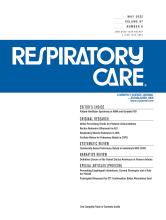To the Editor:
I have read with interest in the American Association for Respiratory Care Clinical Practice Guideline1 on the management of adult patients with oxygen in the acute care setting. The expert panel that prepared the document has tackled a highly controversial topic to provide guidance to the respiratory care community. I would like to comment on their recommended target oxygenation ranges for ARDS and COPD.
The panel recommends that ARDSNet guidance should be followed, with SpO2 kept between 88–95% for patients with ARDS who require oxygen. I believe the stated range represents the oxygenation strategy in the ARDSNet trial protocols and not a scientifically established beneficial oxygen saturation range. One of the several recent randomized controlled trials on ARDS has raised the prospect of harm when targeting SpO2 88–92% instead of SpO2 ≥ 96% (PaO2 90–105 mm Hg).2 This study was prematurely stopped due to excess mortality in the conservative group with 5 mesenteric ischemia events and over 50 subjects inadvertently experiencing blood oxygen tension less than the lower bound for the target. I would raise the question whether we should lower the acceptable range to 88% in any general guidance provided to practitioners in the wake of this safety signal. In the text, the authors recognize the largest randomized controlled trial on the effect of lower or higher oxygenation targets for acute hypoxemic respiratory failure and declare that the range SpO2 90–97% is probably safe.3 I concur and suggest this is a more reasonable guideline based on the information available today.
The panel suggests that in-hospital mortality for patients with COPD was lowest when oxygen saturation of 88–92% was targeted based on a study by Echevarria et al.4 Since this study was retrospective, in-hospital mortality was lowest among subjects “who happened to be” within this range and not when intentionally targeted. Further, the analysis was based on a single determination of oxygen saturation upon admission to the hospital. Notwithstanding the strong language in the Echevarria paper that somehow evaded reviewers, I feel we must remember this was an observational study. To my knowledge, adopting the 88–92% range has been shown to reduce mortality in the pre-hospital setting while patients with COPD exacerbation were transported to the hospital.5 We do not yet have high-quality trial data to inform a specific target for in-hospital patients. I also worry about the safety and feasibility of maintaining such a low and narrow target range given the limitations of the respiratory therapist who is charged with taking care of a whole floor. Add onto this the inaccuracy of pulse oximetry under certain conditions and in some populations,6 implementation could be quite challenging. Whereas we are all aware that patients with COPD should not be exposed to hyperoxia, I don’t believe we know enough to recommend a specific range that is easy to implement and effective for in-patients.
Footnotes
- Correspondence: Umur Ş Hatipoğlu MD MBA, Respiratory Institute, Cleveland Clinic, Mail code A-90, 9500 Euclid Avenue, Cleveland, OH 44195. E-mail: HATIPOU{at}ccf.org
Dr Hatipoğlu discloses a relationship with UpToDate and serves as an associate section editor for COPD.
- Copyright © 2022 by Daedalus Enterprises







